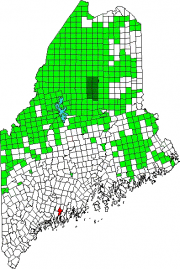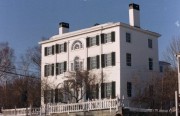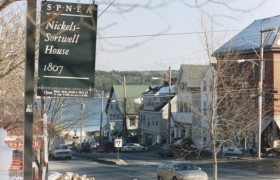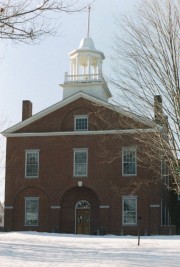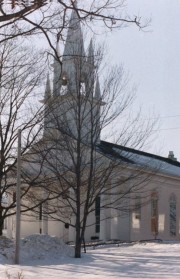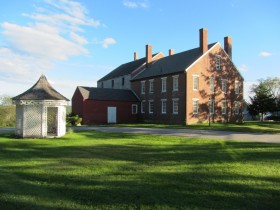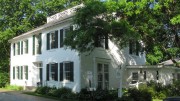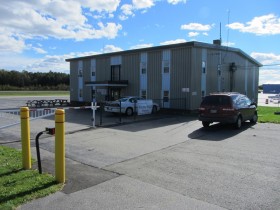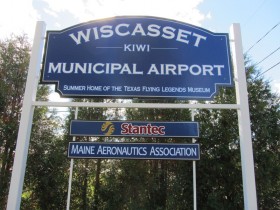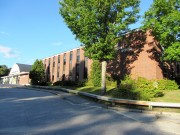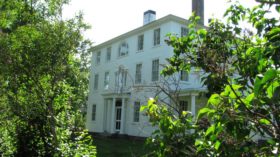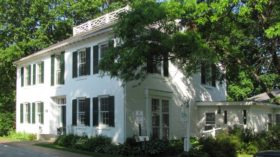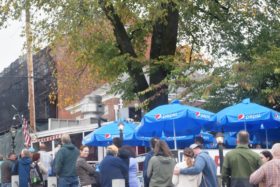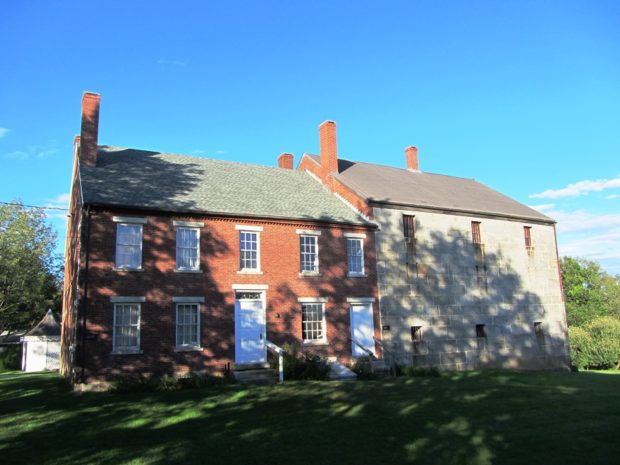
| Year | Population |
|---|---|
| 1970 | 2,244 |
| 1980 | 2,832 |
| 1990 | 3,339 |
| 2000 | 3,603 |
| 2010 | 3,732 |
| Geographic Data | |
|---|---|
| N. Latitude | 44:00:54 |
| W. Longitude | 69:41:20 |
| Maine House | District 87 |
| Maine Senate | District 13 |
| Congress | District 1 |
| Area sq. mi. | (total) 27.7 |
| Area sq. mi. | (land) 24.6 |
| Population/sqmi | (land) 151.7 |
| County: Lincoln | |
[wiss-CASS-et] is a town in Lincoln County, incorporated on February 13, 1760 as the town of Pownalborough from the former Frankfort Plantation.
In 1605, explorer Samuel de Champlain arrived in Wiscasset and met with Native Americans. When the town was established, the Pownalborough Courthouse (in Dresden, once a part of Wiscasset) was built to serve the area. The fifteenth town chartered in Maine, it was named for Massachusetts Governor Thomas Pownall.
A census of “Pownal borough” in 1766 reported 114 families, 100 houses, 26 brick chimneys, and 639 inhabitants.
The name was changed to its Indian designation, Wiscasset, on June 10, 1802. Depending on the source, it means simply “the outlet” (Eckstorm) or “Comes out from but you don’t see where” (Bond).
One can hardly improve on the following account in Isaacson:
First visitor to the site was Samuel de Champlain who met with a group of “savages” July 5, 1605 and “gave them some cakes and peas with which they were greatly pleased.” The English began settling 40 years later, but fled during King Phillip’s War. After 1730, the seaport grew and life became “monstrous fine,” a visitor commented. In 1791 there were 35 square riggers owned here and often a man could walk across the harbor on the decks of ships lying at anchor. A handsome town was built during this era; some of the houses of those days are still in use. (p. 253)
Lincoln County Courthouse above, completed in 1824, is the oldest in continuous use and its records are well preserved. Daniel Webster once haunted its chambers. It shares space on a hill overlooking the main street with the First Congregational Church. The steeple bell and weather vane on the church above were made by Paul Revere.
Lincoln County Historical Association cares for the 1811 Jail and Museum, along with other historic properties in Wiscasset. The brick museum attached to the jail was once the jail keeper’s house.
Governor and judge Samuel E. Smith lived in the community and practiced law here beginning in 1812. Jeremiah Bailey was a resident here when he was elected to Congress in 1834. Franklin Clark and John D. McCrate are two more members of Congress born here.
Civil War General Ellis Spear taught school in Wiscasset until he volunteered for the U.S. Army, later serving with Joshua Chamberlain as his second in command at Gettysburg.
Since 1918 Camp Chewonki has been offering outdoor programs on Chewonki Neck in Wiscasset. This film clip, now preserved at Northeast Historic Film in Bucksport, illustrates camp activities in the 1940s.
On June 20, 1925, two ships, including the USS Bowdoin commanded by explorer Donald MacMillan, left Wiscasset on what was known as “The Greenland Expedition of 1925.” The plan was to use seaplanes to extend the area of exploration. Richard Byrd and his three amphibious planes, sailed on the USS Peary, commanded by Lieutenant Commander Eugene F. McDonald.
According to Raimund E. Goerler, “MacMillan established a tidal observatory station at Etah in northwestern Greenland, conducted important ornithological studies, and took the first natural color photographs in the Arctic. McDonald demonstrated that shortwave radio could be used in the Arctic for long-distance communication.”
Wiscasset Municipal Airport is a general aviation facility serving the Lincoln County area,
The town was once best known for it’s Maine Yankee Atomic Power plant, which generated much energy and controversy. No longer in operation, disputes over the disposition of its dangerous spent fuel continues. This short video clip, at Northeast Historic Film, illustrates the tone of anti-nuclear power arguments made during one of several referendum elections on the issue in the 1980’s. Just close the new window tab to get back to the Encyclopedia.
 Congressional Medal of Honor winner:
Congressional Medal of Honor winner:
JOSEPH S. SMITH
Form of Government: Town Meeting-Select Board-Manager.
More Videos!
Additional resources
Chase, Fannie Scott. Wiscasset in Pownalborough: A History of the Shire Town and the Salient Historical Features of the Territory between the Sheepscot and Kennebec Rivers. Wiscasset, Me. 1967. (Portland, Me. Anthoensen Press)
Dunsford, Allton. Wiscasset Maine. Published by the Wiscasset Public Library. 1988. [Maine State Library]
Goerler, Raimund E. To the Pole:The Diary and Notebook of Richard E. Byrd, 1925-1927. Columbus, Ohio. Ohio State University Press. c1998.
Isaacson, Dorris. Maine: A Guide Downeast.
*Maine. Historic Preservation Commission. Augusta, Me. Text and photos from National Register of Historic Places.
Patterson, William D. Old Wiscasset: Historical Data. Augusta, Me. Augusta Press. 1951. [Maine State Library]
Patterson, William D. Wiscasset in Early Days: Historical Notes Pertaining to the Old Town on the Sheepscot River. Bath, Me. Printed by the Times Co.. c1929. [University of Maine, Raymond H. Fogler Library, Special Collections; Maine State Library]
Sheils, Peggy. “1811 Old Jail and Lincoln County Museum.” Maine Archives and Museums Newsletter. August, 2003. p. 17
National Register of Historic Places – Listings
Photos, and edited text are from nominations to the National Register of Historic Places researched by Maine. Historic Preservation Commission.
Full text and photos are at https://npgallery.nps.gov/nrhp
HESPER and LUTHER LITTLE (wrecked schooners, demolished), Wiscasset waterfront off Water Street
Nickels-Sortwell House, National Historic Landmark
[Northeast corner of Main and Federal Streets] Built in 1807-08, the Nickels-Sortwell House is a splendid example of a large and elaborate frame town house designed in the Adamesque-Federal style. Captain William Nickels, a shipmaster, built this three-story residence. He died shortly thereafter and the house passed through many hands. It was used as a hotel from around 1820 to 1900, when it was acquired by Alvin F. Sortwell. The house was restored by Sortwell in 1917-18. In 1958 Miss Frances Sortwell deeded the mansion to the Society for the Preservation of New England Antiquities.* [See photo above left.]
Red Brick School
[Warren Street] In 1647 the Massachusetts legislature passed a law that every town of fifty families must provide instruction for its children and that each town with 100 families support a school that would fit the youth for the Cambridge College. Wiscasset at that time was part of Massachusetts, a district in the township of Pownalborough. In 1761 at the first town meeting it was decided to obtain a school teacher. Thereafter the official local school was held in the Meeting House, many miles distant from today’s Wiscasset. In those early times, school masters were itinerant instructors who moved about. It was not until 1772 that a separate school budget was available in the Wiscasset District. These schools as such were held in private houses. In 1792 a separate grammar school was built. In 1805 a district school system was adopted. These early schools were grammar schools only. By 1807 more than 200 families were living in the Wiscasset District.
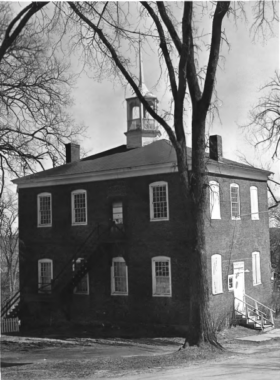 Rev. Hezekiah Packard, Pastor of the First Parish Church, pointed out that no secondary education was being provided. He undertook the private instruction of the promising young men in and about Wiscasset. With the advent of Rev. Packard’s efforts a popular desire for the facilities of a higher education in town emerged. In 1807 a committee to provide a brick building for the Wiscasset Academical Association was appointed. The school house was then built and still stands on Warren Street.
Rev. Hezekiah Packard, Pastor of the First Parish Church, pointed out that no secondary education was being provided. He undertook the private instruction of the promising young men in and about Wiscasset. With the advent of Rev. Packard’s efforts a popular desire for the facilities of a higher education in town emerged. In 1807 a committee to provide a brick building for the Wiscasset Academical Association was appointed. The school house was then built and still stands on Warren Street.
It was used as a school until 1923, when it was used as an American Legion headquarters and as a polling place. In 1958 the old school building was converted to an Art Gallery, now known as The Maine Art Gallery. * [State Parks and Recreation Commission photo, 1970]
Scott, Capt. George, House
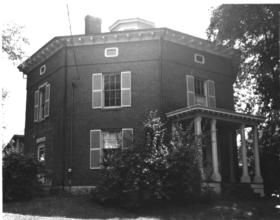 [Federal Street] The Capt. George Scott House is a specimen of an octagonal house following closely plans developed by Orson Squire Fowler (1809-1887) and published in the second edition of “A Home for All,” 1854. It appears to be a nearly perfect brick example built at the time of that type’s first nationwide popularity in an area that resisted the trend.
[Federal Street] The Capt. George Scott House is a specimen of an octagonal house following closely plans developed by Orson Squire Fowler (1809-1887) and published in the second edition of “A Home for All,” 1854. It appears to be a nearly perfect brick example built at the time of that type’s first nationwide popularity in an area that resisted the trend.
Capt. Scott, 35 years old at the time the house was built, was already a famous ship’s master. He had married in 1849 and taken his bride to Madeira on a honeymoon on his command, the ship Smyrna. Before the year was out, the Scotts continued their voyage to California. Other ships he sailed included the Glengarry, J. S. Parsons, Adrian and, during the Civil War, the gunboat Estrella. Capt. Scott made two voyages around the Horn. His last command was the EmiIy McNear.* [State Parks and Recreation Commission photo, 1970]
U.S. Customhouse (Old Customhouse) and Post Office
 [Water Street] Wiscasset Point has, since 1791 been the seat of a custom house for the river and contiguous portions of the sea. It was established a port of entry by the Massachusetts Legislature in 1789 and it was discontinued in 1913, the records being removed in the spring of 1932 to the custom house at Bath. Before the federal constitution was in effect, the state of Massachusetts received and levied its own duties, and appointed the officers who collected them. Naval offices were opened for the entrance and clearance of vessels, records being kept by a naval officer appointed for that purpose.
[Water Street] Wiscasset Point has, since 1791 been the seat of a custom house for the river and contiguous portions of the sea. It was established a port of entry by the Massachusetts Legislature in 1789 and it was discontinued in 1913, the records being removed in the spring of 1932 to the custom house at Bath. Before the federal constitution was in effect, the state of Massachusetts received and levied its own duties, and appointed the officers who collected them. Naval offices were opened for the entrance and clearance of vessels, records being kept by a naval officer appointed for that purpose.
In 1789 President Washington nominated Francis Cook for the office of collector of customs at Wiscasset and the Senate confirmed him. In 1791 Cook was given an additional appointment under the Act for the collecting of internal revenue. The commission of his permanent names Francis Cook “Inspector of the Revenue for the several ports within the District of Wiscasset in Massachusetts.” Cook held this office for thirty-eight years.
When his house was built on Main Street, in 1795, Cook kept the customhouse office in a little building on his land. This first custom house was afterward hauled away and eventually burned. On March 13, 1790, David Silvester was appointed by the legislature collector of excise for the western district of Lincoln County. Several years later a custom house designed by Alexander Johnson, Jr., was erected near the shore at the Point, close to Whaleship Wharf. The Wiscasset custom house was one of the buildings burned in the devastating fire of October 8, 1866.
In April, 1870, the “new” custom house, in which the post-office was also housed, was opened. It occupies a lot on the north side of Front Street, between Water and Middle Streets. The Custom House in Wiscasset celebrated its hundredth anniversary on April 15, 1970. It is no longer a custom house and post office, but is privately owned. * [State Parks and Recreation Commission photo, 1970]
Wiscasset Historic District
[roughly Parker, Dresden, Bradford, Main, and Federal Streets] Wiscasset is an authentic late 18th and 19th century sea and river port. Its growth is visible in its buildings that remain, as a whole, intact and are a type of field museum. The town is known for its historic setting and by its inclusion in many books about New England towns of note.
The boundaries of the Wiscasset Historic District have been drawn to encompass the historic village and its waterfront along the Sheepscot River. Among the many buildings in the district are Castle Tucker, the Old Jail, the Nickel-Sortwell House, and the Wiscasset Library. [See photos above.]
Wiscasset’s location overlooking a deep harbor, well protected from pirates and privateers, made her a logical place for shipping. The town grew from the waterfront back. The prosperous ended with the Embargo Acts and the War of 1812. With the affluence occurring around 1800, grander homes were built. Today one sees those about the “rim” as a series of fires gutted the center of town.
Equally important to the town are the homes that stretch out Federal Street, a true road of 19th century living changed by newer buildings. Wiscasset is proud of its heritage and strives to preserve its cultural and esthetic environment. Many of the present owners are descendants of the builders of these homes. The constant stream of tourists pausing before these houses reflects the importance of preserving Wiscasset’s best natural resource.
Wiscasset Historic District Additional Documentation, First Congregational Church, 1909
In 1973, the Wiscasset Historic District was listed in the National Register. Referred to as “the Prettiest Village in Maine”, Wiscasset is a coastal town on the Sheepscot River that flourished in the years before Maine statehood (1820). It then stalled, both economically and architecturally, in the middle and late decades of the 19th-century. In the early 20th century the town started to be known for its well preserved collection of historic buildings which included many pre-Revolutionary homes, as well as important examples of Federal style residential and public architecture. The district includes over 200 buildings and has a period of significance that ranges from 1739 to 1870.
Additional documentation was later approved by the National Register to formally extend the period of significance to 1909 in order to include the significance of the third edition of the First Congregational Church, designed by John Calvin Stevens and John Howard Stevens. Immediately to the north of the church is the 1824 Lincoln County Court House. This pair of buildings, located uphill from the river and fronted by the common at the top of Main Street, compose an imposing, iconic landmark overlooking the residential and commercial heart of the town. Specifically intended to reference a similar, 1840 Samuel Melcher III designed church which burned in 1907, this excellent piece of Colonialrevival architecture provides continuity of the style, massing, design and workmanship with the Colonialrevival and Federalrevival architecture of the town, even as it preserves the setting, and feeling of the common and monumental public buildings that historically characterized Wiscasset.
Wiscasset Jail and Museum
[Maine Route 218] Lincoln County has built two jails since its formation in 1760 but neither was designed to hold prisoners for long terms. By 1807, the population had increased, the port towns were crowded with shipping and a great lumber industry had developed. The influx of seamen and woodsmen introduced an element of disorder new to the community. A small wooden jail was no longer adequate.
The new jail was completed in 1811 with granite walls from the Edgecomb quarries. Forty prisoners could be held in the twelve cells. Fire destroyed the jailer’s house and it was replaced in 1837 by the present brick house. In it the jailer’s wife prepared meals for prisoners and other inmates who at times numbered as many as fifty. Poor debtors, women prisoners, the sick and insane were quartered on the third floor of the jail and in the attic rooms of the jailer’s house. From 1811 until the State Prison was built in 1821, the Jail was the principal penitentiary in Maine.
In 1954 it was given to the Lincoln County Cultural and Historical Association with the stipulation that it be open to the public at least two months each year. The attached jailer’s house became a museum [See photo above.]
2021
On the West side of Main Street restaurants and other eateries emerge in summer to over look Pottle and Hilton Coves.
A major attraction in downtown Wiscasset is the famed Red’s Eats. On any day, other than in winter, throngs of people (most from “away”) line the sidewalk awaiting to eat and to brag that they had been there. Nestled at the foot of the East side of Wiscasset’s Main Street for 81 years Red’s Eats the most famous restaurant on U.S. Route 1 in Maine. It claims the “Best Lobster Rolls in the Northeast.” Not to mention from steaks to hotdogs; onion rings to fried zucchini and more.


